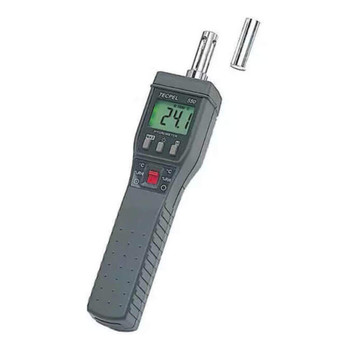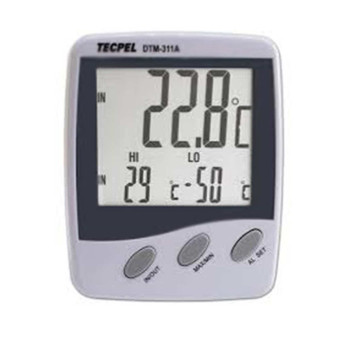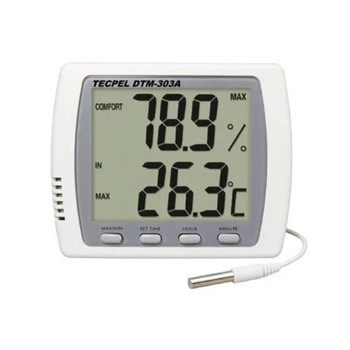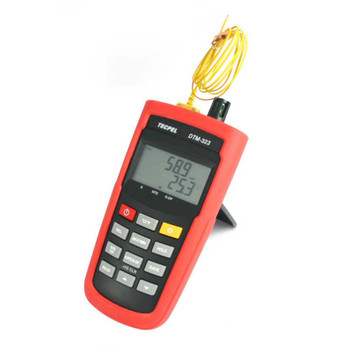Hygrometer
Hygrometer - or Simply Put a Humidity Meter
A hygrometer is a device used to measure the relative humidity of the air or the amount of invisible water vapor present in a specific environment. Digital hygrometers range from basic instruments such as the hair hygrometer to more complex ones such as the cooled mirror dew point hygrometer. Dew point hygrometer measures humidity based on condensation temperature. In addition to their application in meteorology, a hygrometer have a variety of other uses. Saunas, museums, residential facilities, and the HVAC industry, to name a few. It is a practical instrument in the industry, as changes in humidity can negatively impact the production of the materials.
There are several varieties of hygrometers based on their working principle, but they all provide the user with humidity measurements in essentially the same way. The three most common types are:
- Electrical hygrometer
- Psychrometer
- Dew point hygrometer
Also, a thermo hygrometer is a specific kind of hygrometer. It monitors both temperature and humidity.
You can browse different digital hydrometer types here. It might bring lots of questions into your mind. If so, our experienced professionals are here to tell you a hygrometer price or any technical issues. Contact us: +9714337738
Want to know more about a digital hygrometer? here is what you need:
What Is The Concept and Use of Industrial Hygrometer
-

Configurable Thermometer or Hygrometer LTS12 Series
LAE ELECTRONIC
Applications The LTS12 Series is designed for versatile temperature and humidity measurement applications. This product is ideal for environments where precise monitoring and configuration are essential. Temperature Measurement The LTS12 Series excels... -

Digital Thermo Hygrometer - DTM-550
Tecpel
Tecpel Hygrometer Measuring Temperature and Humidity - DTM-550 MAX, DATA, HOLD function, lightweight design, Easy Use, CE Mark - Accurate and Reliable A thermometer measures the temperature of the environment or material that we are operating on. Two... -


Digital Thermo Hygrometer - DTM-311A
Tecpel
A thermometer measures the temperature of the environment or material that we are operating on. Two means help the thermometer to display the signal. First, the digital sensor in infrared models, and secondly the converter that... -

Digital Thermo Hygrometer - DTM-303H
Tecpel
A thermometer measures the temperature of the environment or material that we are operating on. Two means help the thermometer to display the signal. First, the digital sensor in infrared models, and secondly the converter that... -


Digital Thermo Hygrometer - DTM-303B
Tecpel
TECPEL Digital Temperature humidity meter - DTM-303B Dual row display, with 3 meters extension wire with sensor, Accurate and Reliable A thermometer measures the temperature of the environment or material that we are operating on. A Hygro... -

Digital Thermo Hygrometer - DTM-303A
Tecpel
TECPEL Digital Temperature humidity meter - DTM-303A Dual row display, with 3 meters extension wire with sensor, Accurate and Reliable A thermometer measures the temperature of the environment or material that we are operating on. A Hygro... -


Digital Thermo Hygrometer - DTM-302
Tecpel
Large Display digital Thermometer / Hygrometer Hygro thermometer House hold Temperature Humidity meter Features : * indoor temperature display, indoor humidity display * temperature unit °C/°F changeable * memory of MAX/MIN... -

Digital Thermo Hygrometer - DTM-301H
Tecpel
Tecpel Thermometer/Hygrometer - DTM-301H Large Display, lightweight design, °C and °F range selectable – Accurate and Reliable A thermometer measures the temperature of the environment or material that we are operating on. Two means help... -

Digital Thermo Hygrometer - DTM-20RP31
Tecpel
A thermometer measures the temperature of the environment or material that we are operating on. Two means help the thermometer to display the signal. First, the digital sensor in infrared models, and secondly the converter that shows... -

Digital Thermo Hygrometer - DTM-20
Tecpel
A thermometer measures the temperature of the environment or material that we are operating on. Two means help the thermometer to display the signal. First, the digital sensor in infrared models, and secondly the converter that shows... -

Digital Thermo Hygrometer - DTM-323
Tecpel
Product Description Digital Hygro Thermometer Model: DTM-323 Highly stable humidity measurement +/-2.5% Processing & RH and temperature simultaneously Two temperature sensors (NTC and K-Type) ...
